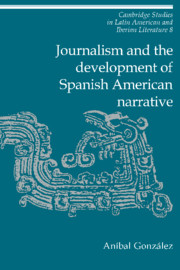Book contents
- Frontmatter
- Contents
- Acknowledgments
- 1 Journalism, modernity, and narrative fiction in Spanish America
- 2 Journalism and (dis)simulation in El Periquillo Sarniento
- 3 Sarmiento and sensationalist journalism: Facundo as crime story
- 4 Journalism versus genealogy: Ricardo Palma's Tradiciones peruanas
- 5 Journalism and the self: the Modernist chronicles
- 6 Journalism and the ethics of writing: Borges, García Márquez, Vargas Llosa, Poniatowska
- Notes
- Bibliography of works cited
- Index
2 - Journalism and (dis)simulation in El Periquillo Sarniento
Published online by Cambridge University Press: 08 October 2009
- Frontmatter
- Contents
- Acknowledgments
- 1 Journalism, modernity, and narrative fiction in Spanish America
- 2 Journalism and (dis)simulation in El Periquillo Sarniento
- 3 Sarmiento and sensationalist journalism: Facundo as crime story
- 4 Journalism versus genealogy: Ricardo Palma's Tradiciones peruanas
- 5 Journalism and the self: the Modernist chronicles
- 6 Journalism and the ethics of writing: Borges, García Márquez, Vargas Llosa, Poniatowska
- Notes
- Bibliography of works cited
- Index
Summary
The butterfly turned into a leaf, the man turned into a woman, but also anamorphosis and trompe-l'oeil, do not copy, are not justified and defined on the basis of true proportions, but instead produce, using the observer's position, bringing him into the imposture, the model's verisimilitude: they incorporate, as in a predatory act, its appearance, they simulate it.
Severo Sarduy, La simulación (1982)His name was Loulou. His body was green, the tips of his wings were pink, his poll blue, and his breast golden.
Gustave Flaubert, “A Simple Heart” (1877)The first work of narrative prose in Spanish America to openly proclaim itself a work of fiction and to associate itself with the novel is El Periquillo Sarniento (1816), by the Mexican pamphleteer José Joaquín Fernández de Lizardi. Elevated to a classic by the Spanish American critical tradition, El Periquillo, like many other classics, is more talked-about than read. Although a substantial body of criticism has already accreted around it, much of that consists of repetitions of prior judgments by earlier analysts of Lizardi's text or of readings that are more attentive to the sociocultural and lexicographic information contained in the text than to its intrinsic formal and rhetorical attributes. Valued mostly for its depiction of the manners and mores of early nineteenth-century Mexico, essentially as a precursor of costumbrismo, scant attention has been paid to its figural elements.
- Type
- Chapter
- Information
- Publisher: Cambridge University PressPrint publication year: 1993

